Abstract
The role of follicle-stimulating hormone (FSH) in the control of spermatogenesis is not well established in any species, including man. We studied the effect of an experimentally-induced, selective FSH deficiency on sperm production in normal men. After a 3-mo control period, five normal men received testosterone enanthate (T) 200 mg i. m. weekly to suppress luteinizing hormone (LH) and FSH, until three successive sperm counts revealed azoospermia or severe oligospermia (sperm counts <3 million/ml). Then, while continuing T, human chorionic gonadotropin (hCG) 5,000 IU i. m. three times weekly was administered simultaneously to replace LH activity, leaving FSH activity suppressed. The effect of the selective FSH deficiency produced by hCG plus T administration on sperm production was determined.
Sperm counts (performed twice monthly throughout the study) were markedly suppressed during T administration alone (1.0±1.0 million/ml mean±SE, compared with 106±28 million/ml during the control period, P < 0.001). With the addition of hCG to T, sperm counts returned toward normal (46±16 million/ml, P < 0.001 compared with T alone). In two subjects, sperm counts during hCG plus T returned into the individual's control range. Sperm motility and morphology were consistently normal in all men during hCG plus T.
Serum FSH levels by RIA were normal (110±10 ng/ml) in the control period and were suppressed to undetectable levels (<25 ng/ml) in the T alone and hCG plus T periods. Urinary FSH excretion was markedly suppressed in the T alone (60±15 mIU/h-2nd IRP, P < 0.01) and hCG plus T (37±9 mIU/h, P < 0.01) periods compared with the control period (334±78 mIU/h).
We conclude that spermatogenesis as assessed by sperm counts, motilities, and morphologies may be reinitiated and maintained at normal levels in men with undetectable blood FSH levels and urinary excretion of FSH less than that of prepubertal children. This conclusion implies that, although FSH may exert effects on human testicular function, maintenance of normal spermatogenesis and reinitiation of sperm production after short-term suppression by exogenous steroids can occur in spite of nearly absent FSH stimulation.
Full text
PDF
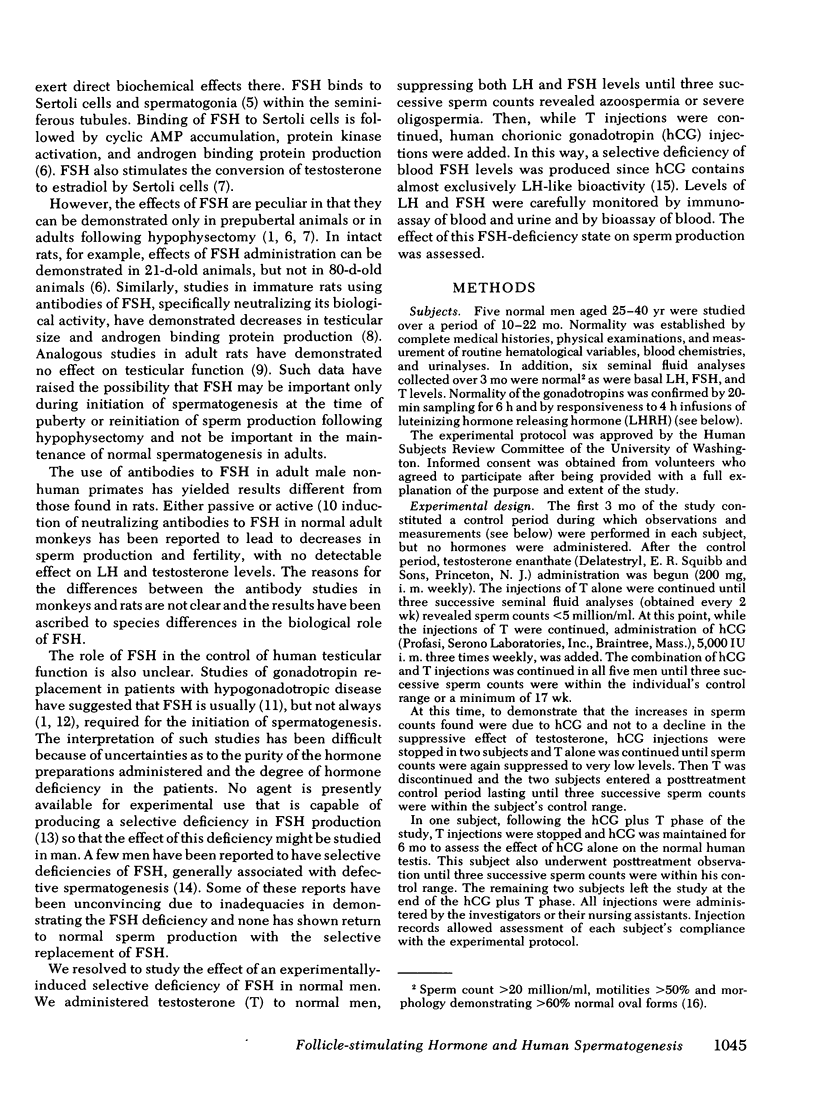
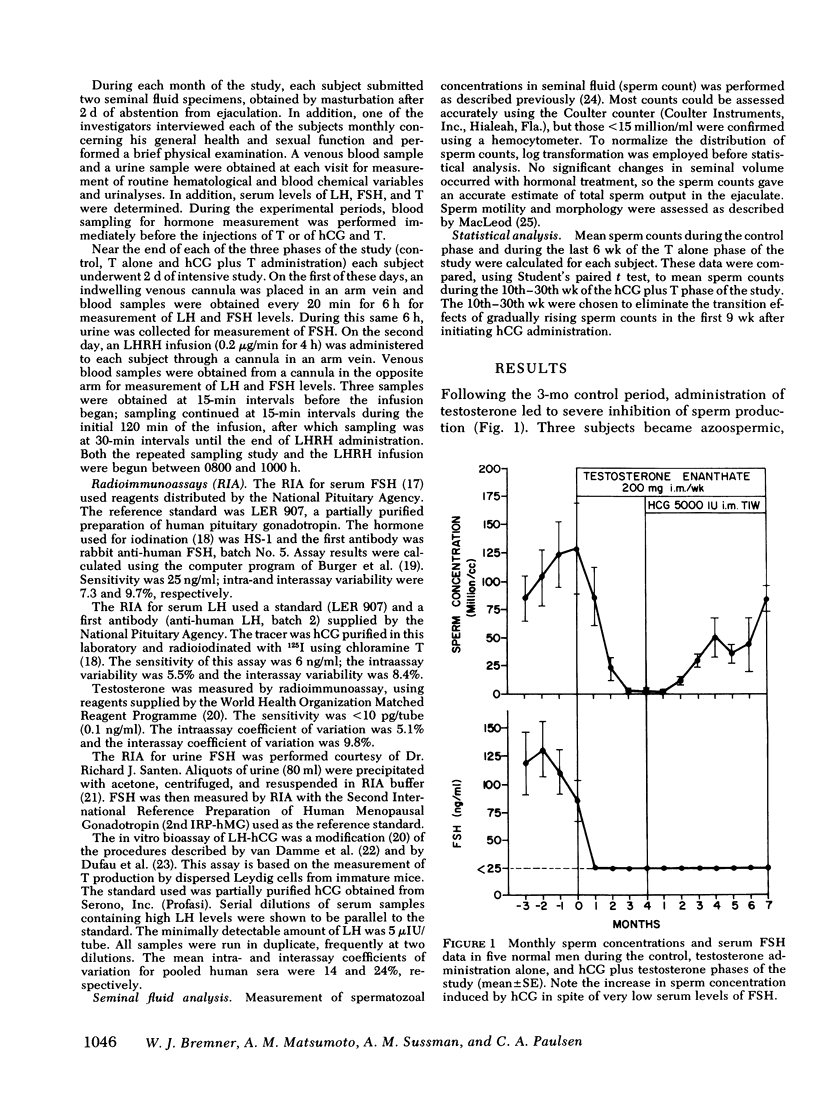
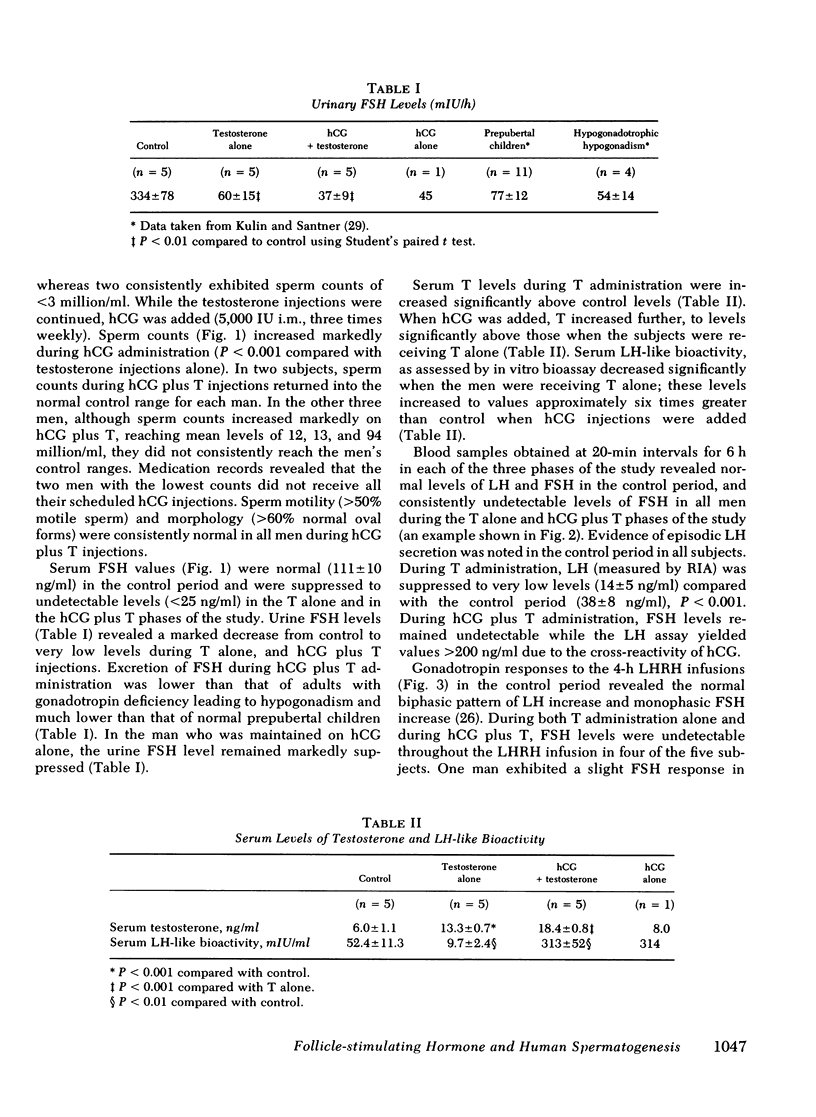
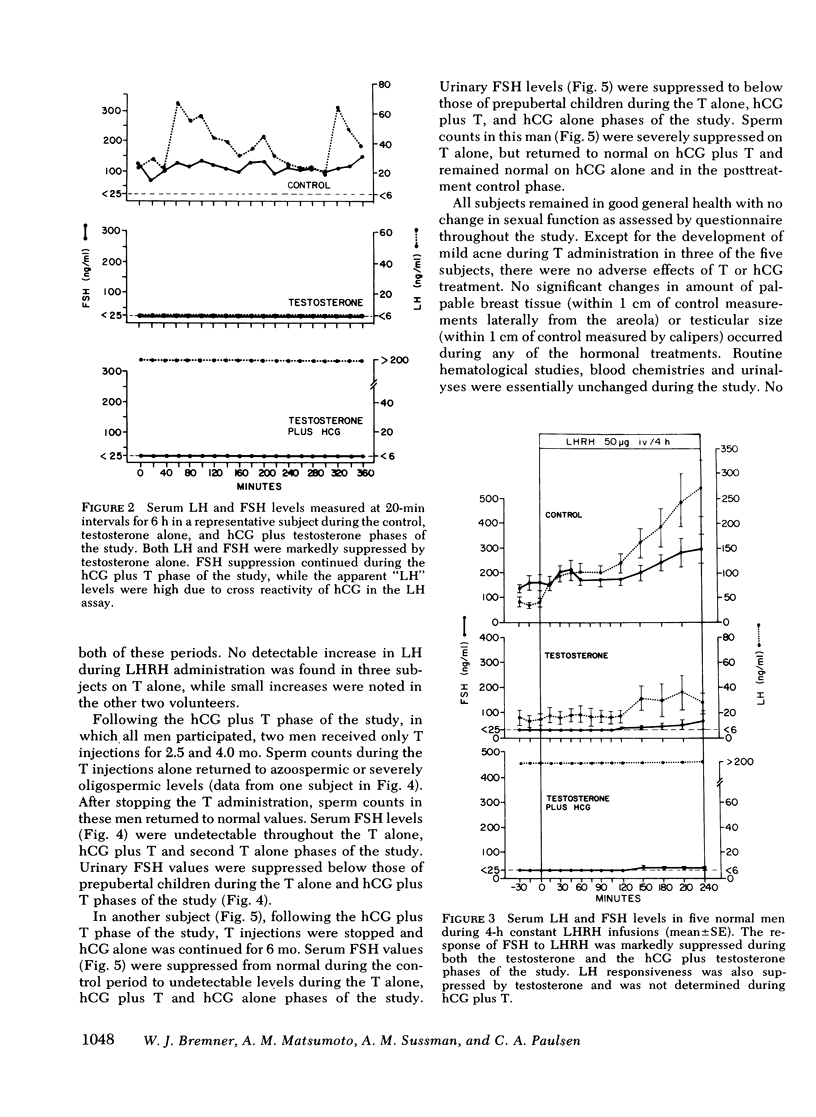
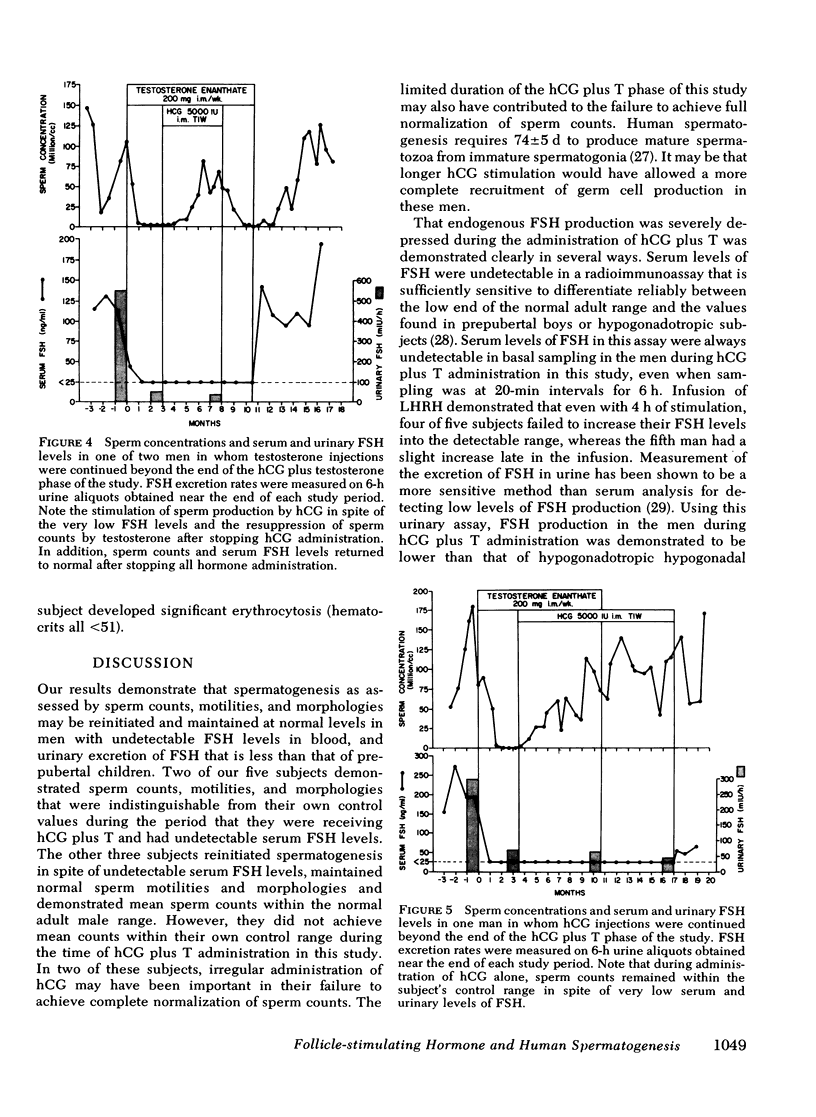

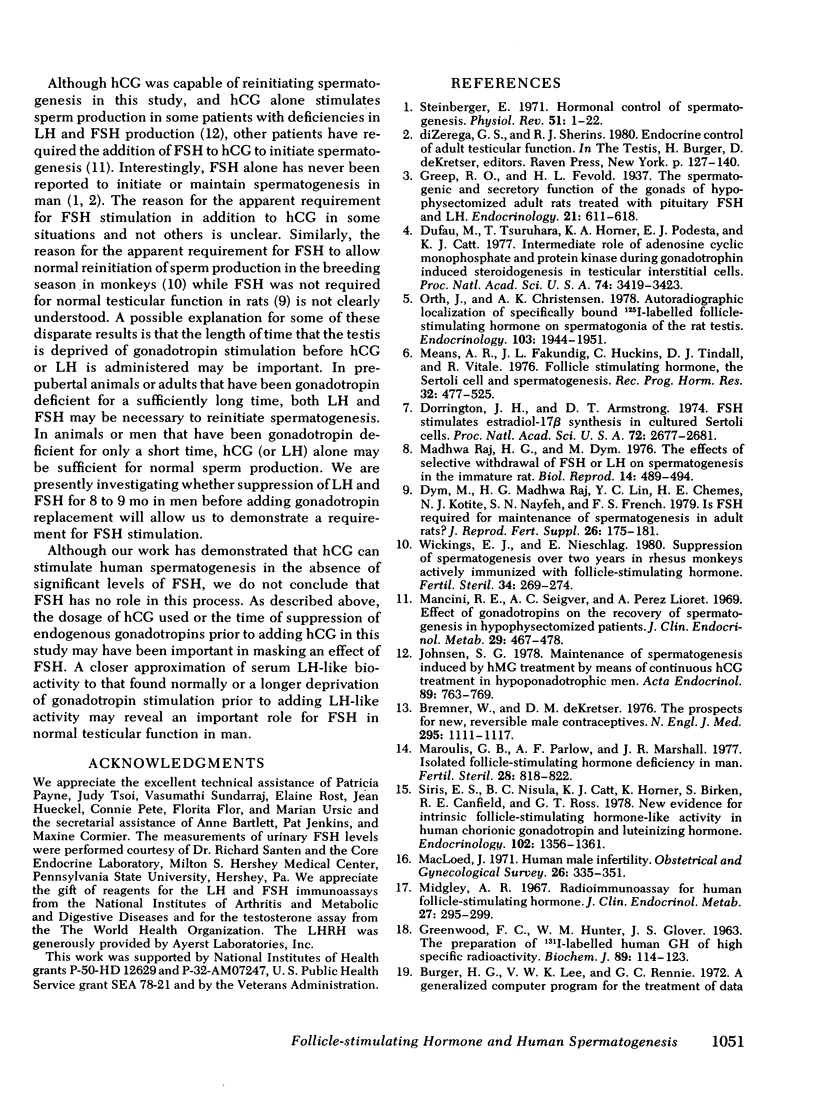
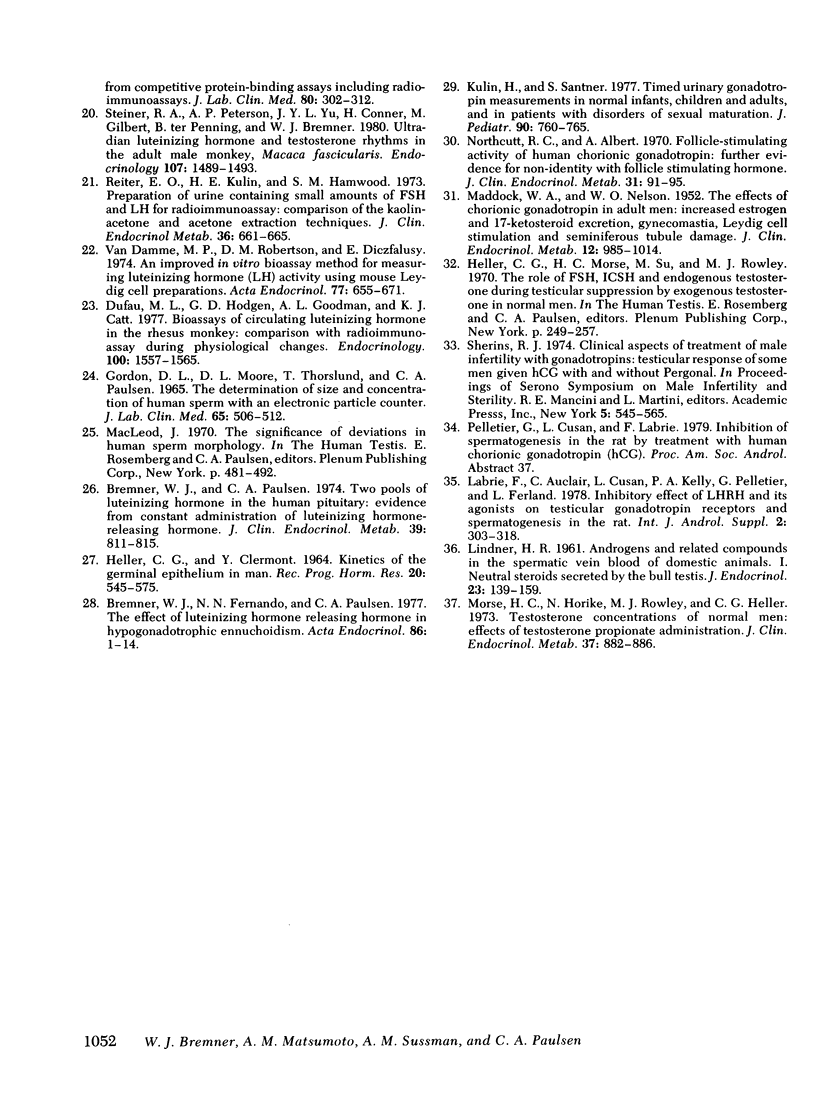
Selected References
These references are in PubMed. This may not be the complete list of references from this article.
- Bremner W. J., Fernando N. N., Paulsen C. A. The effect of luteinizing hormone-releasing hormone in hypogonadotrophic eunuchoidism. Acta Endocrinol (Copenh) 1977 Sep;86(1):1–14. doi: 10.1530/acta.0.0860001. [DOI] [PubMed] [Google Scholar]
- Bremner W. J., Paulsen C. A. Two pools of luteinizing hormone in the human pituitary: evidence from constant administration of luteinizing hormone-releasing hormone. J Clin Endocrinol Metab. 1974 Nov;39(5):811–815. doi: 10.1210/jcem-39-5-811. [DOI] [PubMed] [Google Scholar]
- Bremner W. J., de Kretser D. M. The prospects for new, reversible male contraceptives. N Engl J Med. 1976 Nov 11;295(20):1111–1117. doi: 10.1056/NEJM197611112952005. [DOI] [PubMed] [Google Scholar]
- Burger H. G., Lee V. W., Rennie G. C. A generalized computer program for the treatment of data from competitive protein-binding assays including radioimmunoassays. J Lab Clin Med. 1972 Aug;80(2):302–312. [PubMed] [Google Scholar]
- Dorrington J. H., Armstrong D. T. Follicle-stimulating hormone stimulates estradiol-17beta synthesis in cultured Sertoli cells. Proc Natl Acad Sci U S A. 1975 Jul;72(7):2677–2681. doi: 10.1073/pnas.72.7.2677. [DOI] [PMC free article] [PubMed] [Google Scholar]
- Dufau M. L., Hodgen G. D., Goodman A. L., Catt K. J. Bioassay of circulating luteinizing hormone in the rhesus monkey: comparison with radioimmunoassay during physiological changes. Endocrinology. 1977 Jun;100(6):1557–1565. doi: 10.1210/endo-100-6-1557. [DOI] [PubMed] [Google Scholar]
- Dufau M. L., Tsuruhara T., Horner K. A., Podesta E., Catt K. J. Intermediate role of adenosine 3':5'-cyclic monophosphate and protein kinase during gonadotropin-induced steroidogenesis in testicular interstitial cells. Proc Natl Acad Sci U S A. 1977 Aug;74(8):3419–3423. doi: 10.1073/pnas.74.8.3419. [DOI] [PMC free article] [PubMed] [Google Scholar]
- Dym M., Raj H. G., Lin Y. C., Chemes H. E., Kotite N. J., Nayfeh S. N., French F. S. Is FSH required for maintenance of spermatogenesis in adult rats? J Reprod Fertil Suppl. 1979;(26):175–181. [PubMed] [Google Scholar]
- GORDON D. L., MOORE D. J., THORSLUND T., PAULSEN C. A. THE DETERMINATION OF SIZE AND CONCENTRATION OF HUMAN SPERM WITH AN ELECTRONIC PARTICLE COUNTER. J Lab Clin Med. 1965 Mar;65:506–512. [PubMed] [Google Scholar]
- GREENWOOD F. C., HUNTER W. M., GLOVER J. S. THE PREPARATION OF I-131-LABELLED HUMAN GROWTH HORMONE OF HIGH SPECIFIC RADIOACTIVITY. Biochem J. 1963 Oct;89:114–123. doi: 10.1042/bj0890114. [DOI] [PMC free article] [PubMed] [Google Scholar]
- HELLER C. H., CLERMONT Y. KINETICS OF THE GERMINAL EPITHELIUM IN MAN. Recent Prog Horm Res. 1964;20:545–575. [PubMed] [Google Scholar]
- Johnsen S. G. Maintenance of spermatogenesis induced by HMG treatment by means of continuous HCG treatment in hypogonadotrophic men. Acta Endocrinol (Copenh) 1978 Dec;89(4):763–769. doi: 10.1530/acta.0.0890763. [DOI] [PubMed] [Google Scholar]
- Kulin H. E., Santner S. J. Timed urinary gonadotropin measurements in normal infants, children, and adults, and in patients with disorders of sexual maturation. J Pediatr. 1977 May;90(5):760–765. doi: 10.1016/s0022-3476(77)81243-2. [DOI] [PubMed] [Google Scholar]
- LINDNER H. R. Androgens and related compounds in the spermatic vein blood of domestic animals. I. Neutral steroids secreted by the bull testis. J Endocrinol. 1961 Oct;23:139–159. doi: 10.1677/joe.0.0230139. [DOI] [PubMed] [Google Scholar]
- MADDOCK W. O., NELSON W. O. The effects of chorionic gonadotropin in adult men: increased estrogen and 17-ketosteroid excretion, gynecomastia, leydig cell stimulation and semi-niferous tubule damage. J Clin Endocrinol Metab. 1952 Aug;12(8):985–1014. doi: 10.1210/jcem-12-8-985. [DOI] [PubMed] [Google Scholar]
- MacLeod J. Human male infertility. Obstet Gynecol Surv. 1971 May;26(5):335–351. doi: 10.1097/00006254-197105000-00001. [DOI] [PubMed] [Google Scholar]
- Madhwa Raj H. G., Dym M. The effects of selective withdrawal of FSH or LH on spermatogenesis in the immature rat. Biol Reprod. 1976 May;14(4):489–494. doi: 10.1093/biolreprod/14.4.489. [DOI] [PubMed] [Google Scholar]
- Mancini R. E., Seiguer A. C., Lloret A. P. Effect of gonadotropins on the recovery of spermatogenesis in hypophysectomized patients. J Clin Endocrinol Metab. 1969 Apr;29(4):467–478. doi: 10.1210/jcem-29-4-467. [DOI] [PubMed] [Google Scholar]
- Maroulis G. B., Parlow A. F., Marshall J. R. Isolated follicle-stimulating hormone deficiency in man. Fertil Steril. 1977 Aug;28(8):818–822. doi: 10.1016/s0015-0282(16)42734-2. [DOI] [PubMed] [Google Scholar]
- Means A. R., Fakunding J. L., Huckins C., Tindall D. J., Vitale R. Follicle-stimulating hormone, the Sertoli cell, and spermatogenesis. Recent Prog Horm Res. 1976;32:477–527. doi: 10.1016/b978-0-12-571132-6.50027-0. [DOI] [PubMed] [Google Scholar]
- Midgley A. R. Radioimmunoassay for human follicle-stimulating hormone. J Clin Endocrinol Metab. 1967 Feb;27(2):295–299. doi: 10.1210/jcem-27-2-295. [DOI] [PubMed] [Google Scholar]
- Morse H. C., Horike N., Rowley M. J., Heller C. G. Testosterone concentrations in testes of normal men: effects of testosterone propionate administration. J Clin Endocrinol Metab. 1973 Dec;37(6):882–886. doi: 10.1210/jcem-37-6-882. [DOI] [PubMed] [Google Scholar]
- Northcutt R. C., Albert A. Follicle-stimulating activity of human chorionic gonadotropin: Further evidence for non-identity with follicle-stimulating hormone. J Clin Endocrinol Metab. 1970 Jul;31(1):91–95. doi: 10.1210/jcem-31-1-91. [DOI] [PubMed] [Google Scholar]
- Orth J., Christensen A. K. Autoradiographic localization of specifically bound 125I-labeled follicle-stimulating hormone on spermatogonia of the rat testis. Endocrinology. 1978 Nov;103(5):1944–1951. doi: 10.1210/endo-103-5-1944. [DOI] [PubMed] [Google Scholar]
- Reiter E. O., Kulin H. E., Hamwood S. M. Preparation of urine containing small amounts of FSH and LH for radioimmunoassay: comparison of the kaolin-acetone and acetone extraction techniques. J Clin Endocrinol Metab. 1973 Apr;36(4):661–665. doi: 10.1210/jcem-36-4-661. [DOI] [PubMed] [Google Scholar]
- Siris E. S., Nisula B. C., Catt K. J., Horner K., Birken S., Canfield R. E., Ross G. T. New evidence for intrinsic follicle-stimulating hormone-like activity in human chorionic gonadotropin and luteinizing hormone. Endocrinology. 1978 May;102(5):1356–1361. doi: 10.1210/endo-102-5-1356. [DOI] [PubMed] [Google Scholar]
- Steiner R. A., Peterson A. P., Yu J. Y., Conner H., Gilbert M., terPenning B., Bremner W. J. Ultradian luteinizing hormone and testosterone rhythms in the adult male monkey, Macaca fascicularis. Endocrinology. 1980 Nov;107(5):1489–1493. doi: 10.1210/endo-107-5-1489. [DOI] [PubMed] [Google Scholar]
- Van Damme M. P., Robertson D. M., Diczfalusy E. An improved in vitro bioassay method for measuring luteinizing hormone (LH) activity using mouse Leydig cell preparations. Acta Endocrinol (Copenh) 1974 Dec;77(4):655–671. doi: 10.1530/acta.0.0770655. [DOI] [PubMed] [Google Scholar]
- Wickings E. J., Nieschlag E. Suppression of spermatogenesis over two years in rhesus monkeys actively immunized with follicle-stimulating hormone. Fertil Steril. 1980 Sep;34(3):269–274. doi: 10.1016/s0015-0282(16)44961-7. [DOI] [PubMed] [Google Scholar]


